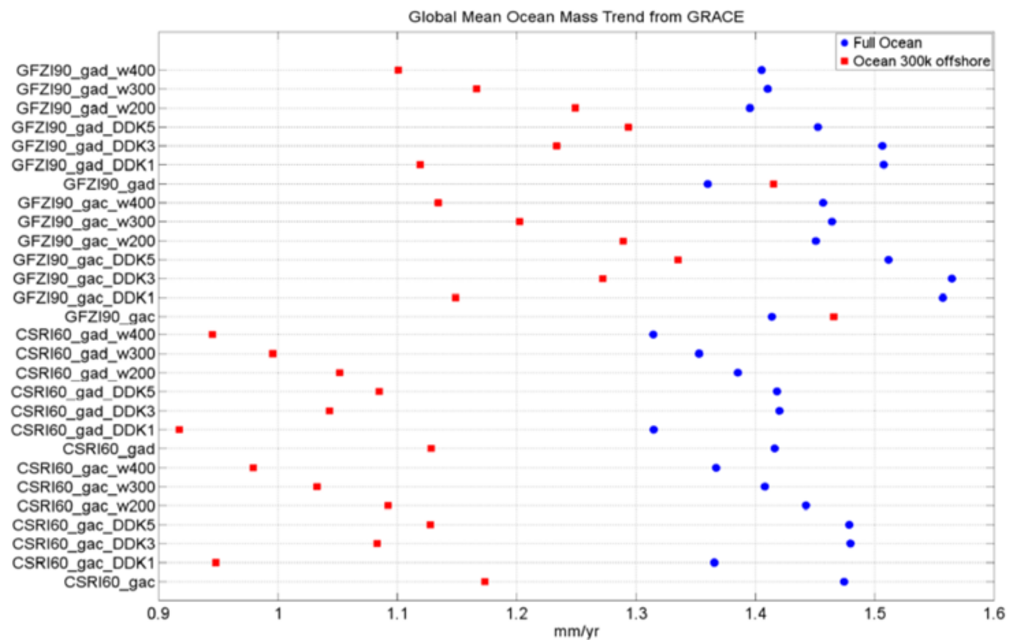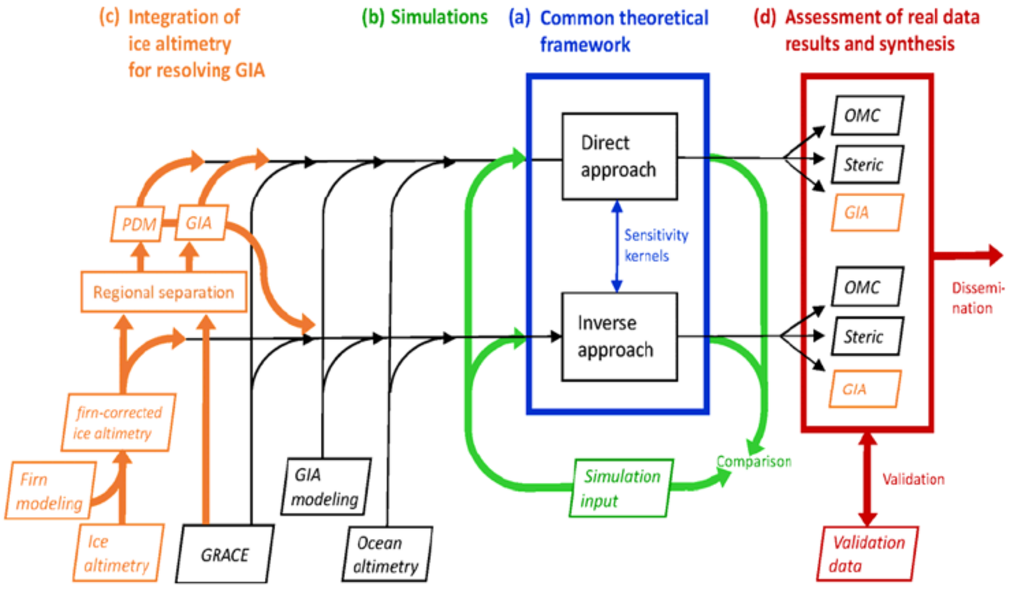OMCG
Reconciling ocean mass change and GIA from satellite gravity and altimetry (OMCG)
Ocean mass change (OMC) is a major component of the sea level budget. OMC is subtracted from altimetry-based ocean volume changes to infer steric sea level variations, with consequences for ocean heat content (OHC) estimates and for understanding the Earth’s energy budget. GRACE has been instrumental for recent OMC estimates, and it is increasingly used in regional studies. Yet, published estimates of global OMC, from essentially the same GRACE data, vary from 1.2 to 2.0 mm/a (Fig. 1).
GRACE-based OMC estimates have used either ’Direct’ or ’Inverse’ approaches. The groups in Bonn and Dresden have experience with both approaches. The Bonn Group has employed an ’Inverse’ approach, which prescribes a set of patterns of mass change and estimates scaling factors to these patterns in a least-squares adjustment to GRACE results. The prescribed patterns may include the ’fingerprints’ of passive oceanic reaction and rotational feedback, and the approach is easily extended to observations like ocean altimetry.
The problem of GRACE-based OMC errors is intricate since few independent data are available for validation: OBP recorders are sparse and suffer from drifts, tide gauges measure the total effect of OMC, steric sea level, and land motion, and ocean models suffer from data uncertainties and were not designed to reproduce OMC. The Glacial Isostatic Adjustment (GIA) correction, which needs to be applied when assessing ocean volume change from ocean altimetry, OMC from GRACE, is the most difficult to assess error source which is likely on the order of 0.3 mm/a or higher, due to the uncertainty of the underlying assumption on glacial history and Earth rheology.
The central hypothesis of this project is that these discrepancies are mostly related to (1) method issues in the analysis of the GRACE data and (2) the unsolved problem of correcting for the effect of GIA. Consequently, we aim to resolve conflicting mass/steric sea level budget partitioning, as well as providing consolidated and consistent gridded OMC to the SPP and the community (Fig. 2).
To reach our objectives within the project, we will work on the following main challenges:
- Express the 'Direct' and 'Inverse' approaches in a joint theoretical framework to understand their differences and their equivalences.
- Investigate 'Direct' and 'Inverse' approaches in a joint comprehensive consistent simulation.
- Resolve GIA together with OMC and the ice sheet contribution to OMC by integrating satellite altimetry over the ice sheets as an additional observable. This will reduce the GIA-related uncertainty of present-day OMC. The implied improvement of ice sheet change estimates will aid the understanding of ice sheet mass balance and ice-ocean-solid Earth interaction and will thereby aid OMC predictions.
- Assess real-data results, disseminate them within and beyond the SPP.
The Bonn and Dresden groups will collaborate to develop a common theoretical framework for assessing various approaches and the resulting performance for OMC.
In Bonn, we will focus on extending the ESA Earth System Model (ESA-ESM) to the consistent simulation of ocean altimetry and OMC by simulating a truth steric model, as well as truth and noise-corrupted along-track ocean altimetry. In a next step, we will conduct a thorough assessment of the Direct and Inverse methods in terms of consistency and uncertainty. For the Direct approach, this includes investigations of buffer zones, filtering, degree 1 (reference frame) and not well deter- mined low degree coefficients (e.g. C20). With respect to the inverse approach, we will investigate the assumption of time invariant spatial patterns, unmodeled processes, such as wind driven ocean dynamics, spatial resolution, number of fingerprints employed, and, for the Bonn Inverse Approach, adding complementary altimetry data in addition to the currently used Jason-1 and -2 missions. In addition we will examine effects that affect both the Direct and Inverse approaches, such as leakage effects from land hydrology.
The Dresden group will prepare ice sheet altimetry, in conjunction with firn modeling results for a later consistent integration in global inversion schemes. This preparation includes a consistent stochastic error characterisation of the input datasets as well as a regional separation of ice mass change and GIA from the combination of ice altimetry and GRACE. This work also prepares additional input to the simulation studies for GRACE OMC method assessments.
Afterwards, the Bonn Group will work with the Dresden Group on the integration of ice sheet altimetry in global OMC estimates in order to better resolve GIA. We will investigate different approaches to do so. For example, GIA solutions from the regional GRACE-ice altimetry analyses will be incorporated. Glaciologically realistic patterns of ice mass change derived from ice altimetry will be used to replace or complement the patterns that are traditionally employed in the Inverse Approach. In addition, we plan to also directly utilize firn-corrected ice altimetry results as an additional observable in the global inversion approach. We will then use the inversion for separating present-day mass change and GIA in a joint global inversion scheme incorporating GRACE and ocean altimetry data.
Finally, we validate our results against independent data sets, interpret the resulting budgets for our focus regions, such as South Asia, and disseminate them to the SPP.
Publications of the OMCG project:
Fenoglio L., S. Dinardo, B. Uebbing, C. Buchhaupt, J. Kusche, M. Becker (2018). Calibrating Cryosat-2 and Sentinel-3A sea surface heights along the German coast, IAG Proceeding, Springer, in review.


